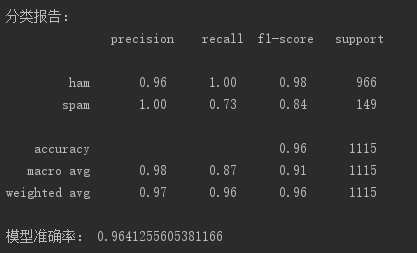1.读取
def read_dataset():
file_path = r'C:Userslucas-lywPycharmProjectshelloSMSSpamCollection'
sms = open(file_path, encoding='utf-8')
sms_data = []
sms_label = []
csv_reader = csv.reader(sms, delimiter=' ')
for line in csv_reader:
sms_label.append(line[0]) # 提取出标签
sms_data.append(preprocessing(line[1]))
sms.close()
2.数据预处理
# 根据词性,生成还原参数pos
# 预处理
def get_wordnet_pos(treebank_tag):
if treebank_tag.startswith('J'):
return nltk.corpus.wordnet.ADJ
elif treebank_tag.startswith('V'):
return nltk.corpus.wordnet.VERB
elif treebank_tag.startswith('N'):
return nltk.corpus.wordnet.NOUN
elif treebank_tag.startswith('R'):
return nltk.corpus.wordnet.ADV
else:
return nltk.corpus.wordnet.NOUN
def preprocessing(text):
tokens = [word for sent in nltk.sent_tokenize(text) for word in nltk.word_tokenize(sent)]
stops = stopwords.words('english')
tokens = [token for token in tokens if token not in stops] # 去除停用词
tokens = [token.lower() for token in tokens if len(token) >= 3] # 大小写,短词
lmtzr = WordNetLemmatizer()
tag = nltk.pos_tag(tokens) # 词性
# 词性还原
tokens = [lmtzr.lemmatize(token, pos=get_wordnet_pos(tag[i][1])) for i, token in enumerate(tokens)]
preprocessed_text = ' '.join(tokens)
return preprocessed_text
3.数据划分—训练集和测试集数据划分
from sklearn.model_selection import train_test_split
x_train,x_test, y_train, y_test = train_test_split(data, target, test_size=0.2, random_state=0, stratify=y_train)
4.文本特征提取
sklearn.feature_extraction.text.CountVectorizer
sklearn.feature_extraction.text.TfidfVectorizer
from sklearn.feature_extraction.text import TfidfVectorizer
tfidf2 = TfidfVectorizer()
观察邮件与向量的关系
向量还原为邮件
# 转化为向量
from sklearn.feature_extraction.text import TfidfVectorizer
tfidf2 = TfidfVectorizer()
X_train = tfidf2.fit_transform(x_train)
X_test = tfidf2.transform(x_test)
X_train.toarray() # 转换成数组
# 向量还原成邮件
import numpy as np
print("第一封邮件:", X_train.toarray()[0])
a = np.flatnonzero(X_train.toarray()[0]) # 该函数输入一个矩阵,返回扁平化后矩阵中非零元素的位置(index)
print("非零元素的位置:", a)
print("非零元素的值:", X_train.toarray()[0][a])
b = tfidf2.vocabulary_ # 生成词汇表
key_list =[]
for key, value in b.items():
if value in a:
key_list.append(key) # key非0元素对应的单词
print("非零元素对应的单词:", key_list)
print("向量化之前的邮件:", X_train[0])

4.模型选择
from sklearn.naive_bayes import GaussianNB
from sklearn.naive_bayes import MultinomialNB
说明为什么选择这个模型?
def mnb_model(x_train, x_test, y_train, y_test):
mnb = MultinomialNB()
mnb.fit(x_train, y_train)
ypre_mnb = mnb.predict(x_test)
print("预测的准确率:", sum(ypre_mnb == y_test) / len(y_test))
return ypre_mnb

5.模型评价:混淆矩阵,分类报告
from sklearn.metrics import confusion_matrix
confusion_matrix = confusion_matrix(y_test, y_predict)
说明混淆矩阵的含义
from sklearn.metrics import classification_report
说明准确率、精确率、召回率、F值分别代表的意义
# 混淆矩阵、分类报告
from sklearn.metrics import confusion_matrix
from sklearn.metrics import classification_report
cm = confusion_matrix(y_test, ypre_mnb)
cr = classification_report(y_test, ypre_mnb)
print("混淆矩阵:
", cm)
print("分类报告:", cr)
print("模型准确率:", (cm[0][0]+cm[1][1])/np.sum(cm))


混淆矩阵:
TP(True Positive):将正类预测为正类数,真实为0,预测也为0
FN(False Negative):将正类预测为负类数,真实为0,预测为1
FP(False Positive):将负类预测为正类数, 真实为1,预测为0
TN(True Negative):将负类预测为负类数,真实为1,预测也为1
准确率:对于给定的测试数据集,分类器正确分类的样本数与总样本数之比。(TP + TN) / 总样本
精确率:针对预测结果,在被所有预测为正的样本中实际为正样本的概率。TP / (TP + FP)
召回率:在实际为正的样本中被预测为正样本的概率。TP / (TP + FN)
F值:同时考虑精确率和召回率,让两者同时达到最高,取得平衡。F值=正确率 * 召回率 * 2 / (正确率 + 召回率 )
6.比较与总结
如果用CountVectorizer进行文本特征生成,与TfidfVectorizer相比,效果如何?